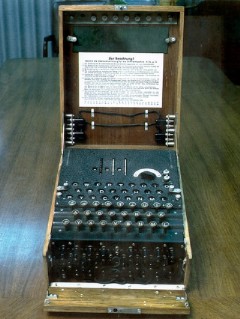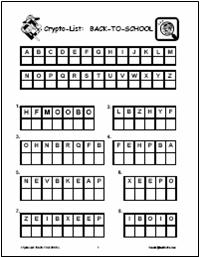Featured Topic: Mathematical Codes

Codes and puzzles such as cryptograms often use letter substitutions to encode messages. Decoding these messages involves looking for patterns and often the simple ones can be decoded by analyzing letter patterns and frequencies.
Many different types of codes have been used throughout history to encrypt messages so that enemies could not intercept them. Caesar is said to have used a simple shift cipher to encode messages. The enigma machine, pictured to the right (from Wikipedia.com), is an example of how encryption was used in WWII Germany. The Navajo Code Talkers used their native language to help the Allied forces encode messages that were difficult to decode.
Cryptology or cryptography is the mathematics of codemaking while cryptanalysis refers to the mathematics of codebreaking. This field of mathematics has become increasingly complex and important with the pervasiveness of internet access to business and personal information. Mathematical encryption is used to ensure that personal information is transmitted across the internet and stored safely so that it cannot easily be read by others.

Navajo Code Talkers
- Learn more about the
 Navajo Code Talkers.
Navajo Code Talkers.
- See
 Code Talkers Lesson Plan that includes the Navajo code words.
Code Talkers Lesson Plan that includes the Navajo code words.
-
 Web Search to find out more about the Navajo Code Talkers and how they encoded and decoded messages.
Web Search to find out more about the Navajo Code Talkers and how they encoded and decoded messages.
Codebreaking Activities
- Contestants on the game show "Wheel of Fortune" also apply their knowledge of letter frequency when they very commonly begin with the letters R, S, T, L, N, E. Are these the most common letters?
- NCTM Illuminations'
 Code Crackers
Code Crackers
Cryptography Resources
- NCTM Illuminations
 Frequency of Letters Chart
Frequency of Letters Chart
- The
 CryptoKid's Website teaches future codemakers and codebreakers about encoding and decoding text.
CryptoKid's Website teaches future codemakers and codebreakers about encoding and decoding text.
- See Ask Oxford.com's
 Frequency of Letters in the English alphabet
Frequency of Letters in the English alphabet
- See
 Wikipedia's Letter Frequency entry which includes graphs.
Wikipedia's Letter Frequency entry which includes graphs.
- Read about how
 Cryptography uses Letter Frequencies.
Cryptography uses Letter Frequencies.
Codemaking and Codebreaking Tools

-
 Caesar Cipher Tool allows you to input text, press a key and get the encrypted text.
Caesar Cipher Tool allows you to input text, press a key and get the encrypted text.
-
 Caesar Cipher 2
Caesar Cipher 2
-
 Letter Frequency Analysis Calculator enables you to type in text and it calculates and graphs the frequency of each letter.
Letter Frequency Analysis Calculator enables you to type in text and it calculates and graphs the frequency of each letter.
- The
 Affine Cipher Calculator enables you to try various substitutions for the code letters.
Affine Cipher Calculator enables you to try various substitutions for the code letters.
Cryptograms
These puzzles are familiar sayings that have been encrypted. Use letter frequencies, letter patterns and your best analytical skills to decode these familiar puzzles that can be found in many puzzle magazines or online.
-
 Cryptogram Corner hosts daily cryptogram puzzles.
Cryptogram Corner hosts daily cryptogram puzzles.
-
 Cryptogram Solving Tool analyzes the frequency of the coded letters and allows the user to substitute letter by letter to solve the cryptogram. Sample cryptograms are available for solution to practice using the tool.
Cryptogram Solving Tool analyzes the frequency of the coded letters and allows the user to substitute letter by letter to solve the cryptogram. Sample cryptograms are available for solution to practice using the tool.
- Discovery School's
 Crytogram Maker allows the user to create a cryptogram from any text.
Crytogram Maker allows the user to create a cryptogram from any text.
- CryptoKids
 Cryptograms challenges the user to decode the puzzles.
Cryptograms challenges the user to decode the puzzles.
Crypto-Lists

These lists were designed to introduce students to codebreaking. Each list contains words that relate to the topic. Use letter frequency and your best analytical skills to decode these lists. Remember that each list uses a different code to encrypt all of the words in that list. Hint: use tally marks to record frequency of each letter in the coded list, then use letter frequency information to break the code. Each activity includes an answer key.

